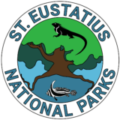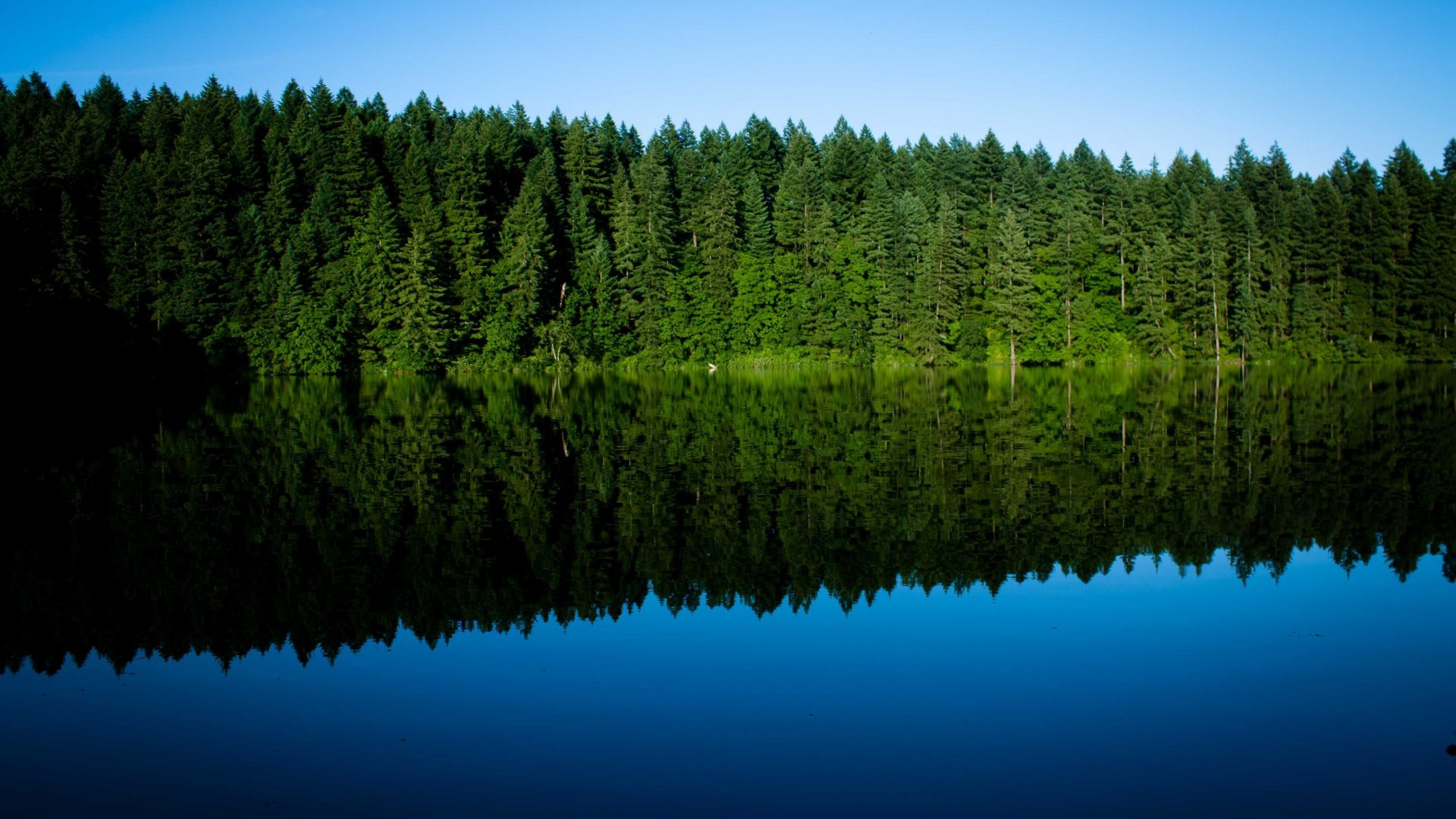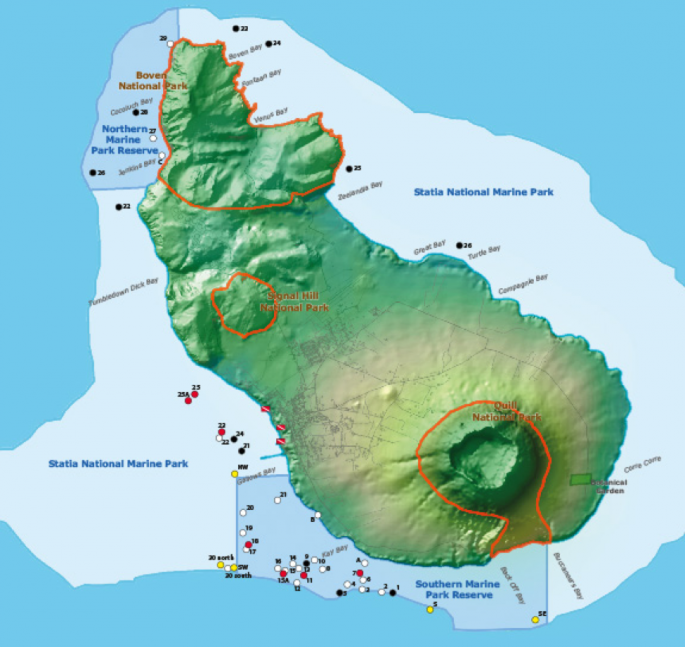Background & scope Based on the proposals submitted by St. Eustatius National Parks Foundation (STENAPA) and Mac & Field, the central government (Ministry of Internal Affairs) granted hurricane relief funds to the Caribbean Netherlands special municipality of St. Eustatius. These funds were directed at restoring the damage to the environment by Hurricanes Irma and Maria in September 2017.
Part of the funds were directed to reforestation activities on the island. The main goals being to: bring back trees in public spaces and peoples yards, combat erosion and restore biodiversity. In collaboration with the local government through the department of Agriculture, Livestock and Fisheries on St. Eustatius (Landbouw Veeteelt en Visserij (LVV)), a plan has been drafted to establish two plant shade houses specifically for the reforestation project.
Cultivating native & naturalized species Currently, the project has around 500 saplings of Pride of Barbados (C. pulcherrima) and Flamboyant Tree better known as the July Tree (Delonix regia). We also have some sugar apple, soursop, pour man’s orchid, sea grape, some manilla – and coconut palms, plenty of gum trees, some locust, moringa, oleander, papayas, mango and passion vine.
All seedlings have been cultivated in the two shade houses on the ReforeStatia plot by collecting seeds and cuttings on St. Eustatius. This is to ensure only native or naturalized species are included in the project and prevent the introduction of invasive species or diseases. Moreover, native and naturalized species are known to thrive in the environment of Statia and thus require less care once the trees and plants reach a certain level of maturity.
Rainwater is collected on-site through localized water catchment systems and we make our own compost that matches the soil characteristics of Statia.
Reforesting degraded and public sites with different purposes Multiple sites with a high potential for reforestation have been identified for replanting. Key factors including erosion control, agroforestry, biodiversity regeneration and beautification have been taken into account for reforestation sites. They will contribute to the regeneration of the island, by profiting not only the environment but also the community by providing fruits and vegetables through agroforestry. We included an example below in three steps to illustrate how we would transform a desolate landscape into a lush forest that can be enjoyed by all.
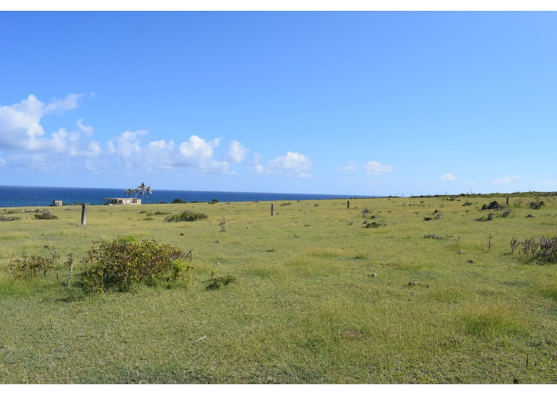
As with nearly all the proposed reforestation sites, the initial state of planting sites resembles barren land. Typically grass and several low shrubs (unpalatable for roaming animals), are all that remain.
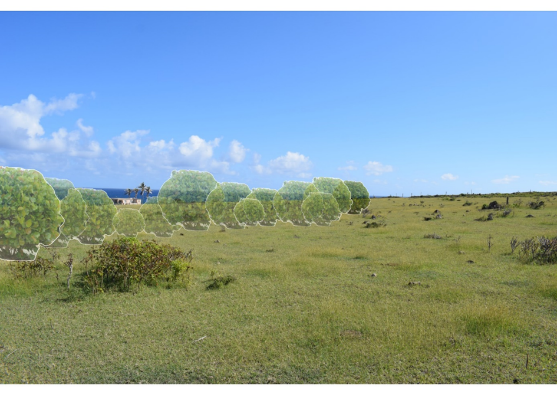
By planting a first line of vegetation (sea grape) a barrier is created that is tolerant of salt spray, high winds and other extreme environmental conditions. This barrier serves an important purpose, namely creating an environment behind the barrier for plants and trees that are less tolerant towards the prior mentioned environmental conditions.
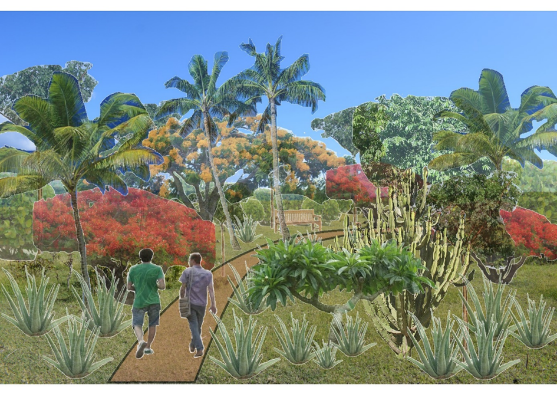
Once the barrier in the prior image has been established, plants hardy enough to thrive in those conditions can then be planted, which in turn make it possible for even more fragile species to be planted. The layering of different plant species will ensure durability within a forest. This image is an artist’s impression of what could be achieved after multiple phases of reforestation have been applied after 5 to 10 years.
Education & community involvement STENAPA’s November school program focused on ReforeStatia. Activities were developed for each of the different groups. Children learned everything from finding seeds, their germination process, such as the early development of their rooting system to how much care trees require in the early stages. Some also learnt about the challenges faced by the reforestation project, and of course, about the value of trees.
To involve the broader community in the reforestation efforts, the project has organized several town hall meetings. During these meetings, the public receives a presentation on the latest developments and gets the opportunity to ask questions and share their input. In addition to these meetings, the project writes a quarterly newsletter and the ranger writes biweekly blogs for STENAPA’s website.
During Statia Week (10-16 November 2019), STENAPA showcased the reforestation project on St. Eustatius. We compiled a list of community members who are willing to join us in our out-planting efforts as we will have a large number of trees ready. The seedlings of moringa, mahogany and others were available in the middle of town for a small donation, which went directly back into the project.
Currently, we are in the process of establishing an expert group of locals who will become community advocates of the project.
Communication & Promotion On Friday, August 30, 2019, we celebrated the grand opening of the ReforeStatia Nursery. After months of hard work, we were able to present the shade houses on a completely fenced off plot where the first trees were already planted. One of the shade houses already holds many juvenile plants. During the opening, visitors received a tour of the site and the first sea grapes were planted on the plot by three special attendees: Deputy Government Commissioner Mervyn Stegers, Agriculture Minister Anthony Reid, and Manager and owner of the Berkel Plantation, Ishmael Berkel.
On the 4th of September, Minister Carola Schouten visited the project as during her first visit to the BES islands. Together with several representatives of Statia government (Interim Director of Economy and Infrastructure Anthony Reid, Senior Communication Advisor Alida Francis, Deputy Government Commissioner Mervyn Stegers, Government Commissioner Marcolino “Mike” Franco and Acting Island Secretary Malvern Dijkshoorn-Lopes), STENAPA presented ReforeStatia as one of the nature-based solutions to combat the heavy erosion, sedimentation and eutrophication, and vulnerability to hurricanes Statia is battling.
On October 7th KLM Royal Dutch Airlines celebrated its 100th anniversary. To commemorate this special occasion, they made a short documentary about the airline and its travelers. Mac & Field were one of the stories covered in the documentary and special attention was placed on their current work in St. Eustatius with STENAPA St Eustatius.


